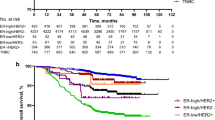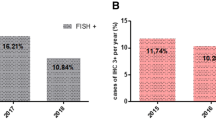Abstract
Smears from paraffin sections from 3,198 cases of surgical resection mammary carcinomas were assessed immunohistochemically for estrogen receptor (ER), progesterone receptor (PR), and human epidermal growth factor receptor 2 (HER2) expressions in National Cancer Center (NCC), China, to explore the correlation of these markers to each other, to tumor histologic subtype, and to explore breast cancer four molecular subtypes clinicopathological characteristics. Pathology material of surgical resection patients presenting to NCC during July 1, 2010–July 1, 2012 were reviewed for patients’ age, tumor size, subtype, grade, and ER, PR, HER2 immunohistochemistry (IHC) status. For HER2 IHC 2+ score cases, fluorescence in situ hybridization was used, as the 2007 American society of clinical oncology/college of American pathologists guidelines. There were 3,198 cases, with a median age of 51 years, a mean tumor size of 2.1 cm, and 42.3 % lymph node positivity. Of all cases, 2,506 (78.4 %) were ER+, 2,548 (79.7 %) were PR+, and 816 (25.5 %) were HER2+. Among the four molecular subtypes of breast cancer, luminal A were the majority accounting for 65.3 %, and triple-negative breast cancer accounted for 9.2 %. ER, PR, and HER2 status showed a direct correlation to tumor onset age, tumor type, and grade of ductal carcinoma. Meanwhile the four subtypes of breast cancer differed from onset age, tumor size, lymph node metastasis, and tumor grade. This study was an important documentation of Chinese breast cancer patients and the report would serve as a baseline for other future studies.
Similar content being viewed by others
Abbreviations
- ER:
-
Estrogen receptor
- PR:
-
Progesterone receptor
- HER2:
-
Human epidermal growth factor receptor 2
- FISH:
-
Fluorescence in situ hybridization
- IHC:
-
Immunohistochemistry
- LBA:
-
Ligand-binding assay
References
Akarolo-Anthony SN, Ogundiran TO, Adebamowo CA (2010) Emerging breast cancer epidemic: evidence from Africa. Breast Cancer Res 12(Suppl 4):S8
Singh R, Gupta S, Pawar SB, Pawar RS, Gandham SV, Prabhudesai S (2014) Evaluation of ER, PR and HER-2 receptor expression in breast cancer patients presenting to a semi urban cancer centre in Western India. J Cancer Res Ther 10(1):26–28
Harvey JM, Clark GM, Osborne CK, Allred DC (1999) Estrogen receptor status by immunohistochemistry is superior to the ligand-binding assay for predicting response to adjuvant endocrine therapy in breast cancer. J Clin Oncol 17(5):1474–1481
Raji A, Lurie RH (2007) Human epidermal growth factor receptor 2 testing recommendation. Arch Pathol Lab Med 131(9):1330–1331; author reply 1331–1333
Zhou XL, Fan W, Yang G, Yu MX (2014) The clinical significance of PR, ER, NF-kappa B, and TNF-alpha in breast cancer. Dis Markers 2014:494581
Carey LA, Perou CM, Livasy CA, Dressler LG, Cowan D, Conway K, Karaca G, Troester MA, Tse CK, Edmiston S et al (2006) Race, breast cancer subtypes, and survival in the Carolina Breast Cancer Study. JAMA 295(21):2492–2502
Brenton JD, Carey LA, Ahmed AA, Caldas C (2005) Molecular classification and molecular forecasting of breast cancer: ready for clinical application? J Clin Oncol 23(29):7350–7360
Parise CA, Bauer KR, Brown MM, Caggiano V (2009) Breast cancer subtypes as defined by the estrogen receptor (ER), progesterone receptor (PR), and the human epidermal growth factor receptor 2 (HER2) among women with invasive breast cancer in California, 1999–2004. Breast J 15(6):593–602
Karger S, Freiburg GH (2010) Pathologists’ guideline recommendations for immunohistochemical testing of estrogen and progesterone receptors in breast cancer. Breast Care (Basel) 5(3):185–187
Althuis MD, Fergenbaum JH, Garcia-Closas M, Brinton LA, Madigan MP, Sherman ME (2004) Etiology of hormone receptor-defined breast cancer: a systematic review of the literature. Cancer Epidemiol Biomark Prev 13(10):1558–1568
Bardou VJ, Arpino G, Elledge RM, Osborne CK, Clark GM (2003) Progesterone receptor status significantly improves outcome prediction over estrogen receptor status alone for adjuvant endocrine therapy in two large breast cancer databases. J Clin Oncol 21(10):1973–1979
King CR, Kraus MH, Aaronson SA (1985) Amplification of a novel v-erbB-related gene in a human mammary carcinoma. Science 229(4717):974–976
Slamon DJ, Clark GM, Wong SG, Levin WJ, Ullrich A, McGuire WL (1987) Human breast cancer: correlation of relapse and survival with amplification of the HER-2/neu oncogene. Science 235(4785):177–182
Esteva FJ (2004) Monoclonal antibodies, small molecules, and vaccines in the treatment of breast cancer. Oncologist 9(Suppl 3):4–9
Singh JC, Jhaveri K, Esteva FJ (2014) HER2-positive advanced breast cancer: optimizing patient outcomes and opportunities for drug development. Br J Cancer
Satti MB (2011) Oestrogen receptor/progesterone receptor and human epidermal growth factor receptor 2 status in breast cancer: a 9-year study at Princess Noorah Oncology Center Saudi Arabia. Histopathol 59(3):537–542
Singh M, Ding Y, Zhang LY, Song D, Gong Y, Adams S, Ross DS, Wang JH, Grover S, Doval DC et al (2014) Distinct breast cancer subtypes in women with early-onset disease across races. Am J Cancer Res 4(4):337–352
Cui Y, Deming-Halverson SL, Shrubsole MJ, Beeghly-Fadiel A, Fair AM, Sanderson M, Shu XO, Kelley MC, Zheng W (2014) Associations of hormone-related factors with breast cancer risk according to hormone receptor status among white and african american women. Clin Breast Cancer
Zell JA, Tsang WY, Taylor TH, Mehta RS, Anton-Culver H (2009) Prognostic impact of human epidermal growth factor-like receptor 2 and hormone receptor status in inflammatory breast cancer (IBC): analysis of 2,014 IBC patient cases from the California Cancer Registry. Breast Cancer Res 11(1):R9
Sorlie T, Perou CM, Tibshirani R, Aas T, Geisler S, Johnsen H, Hastie T, Eisen MB, van de Rijn M, Jeffrey SS et al (2001) Gene expression patterns of breast carcinomas distinguish tumor subclasses with clinical implications. Proc Natl Acad Sci USA 98(19):10869–10874
Abramson VG, Lehmann BD, Ballinger TJ, Pietenpol JA (2014) Subtyping of triple-negative breast cancer: implications for therapy. Cancer
Conflict of interest
The authors declare no conflict of interests.
Author information
Authors and Affiliations
Corresponding author
Rights and permissions
About this article
Cite this article
Zhu, X., Ying, J., Wang, F. et al. Estrogen receptor, progesterone receptor, and human epidermal growth factor receptor 2 status in invasive breast cancer: a 3,198 cases study at National Cancer Center, China. Breast Cancer Res Treat 147, 551–555 (2014). https://doi.org/10.1007/s10549-014-3136-y
Received:
Accepted:
Published:
Issue Date:
DOI: https://doi.org/10.1007/s10549-014-3136-y




